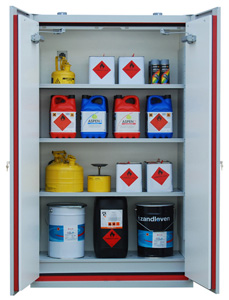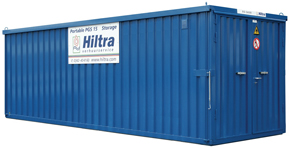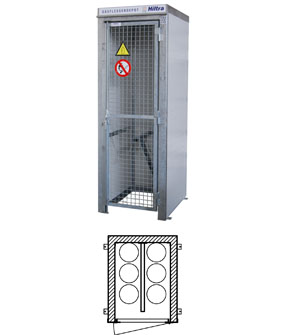On Linkedin, the following quoted article was posted by Mr. Christiaan Dahrs of Peutz BV concerning
fire research on lithium-ion battery cells that we do not want to withhold from our prospects.
State of Charge lithium-ion battery cells
The State of Charge (SOC) level of lithium-ion battery cells often plays no role when looking at safety
is looked at even though it can be influential. Peutz used a simple test to show the difference in effects
investigated by testing some lithium-ion battery cells with different charge levels (25%, 50%, 75%, 100%) to
subjected to a thermal runaway test on a hotplate.
The results confirm the view that an effect difference is indeed present.
A higher loading level leads to higher temperatures (measured on the cell wall) and more severe fire phenomena
during a thermal runaway:
- 25% SOC: Smoke only observed. Max. temperature approx. 572 °C;
- 50% SOC: Smoke, sparks, blow-off and flames observed. Max. temperature approx. 724 °C;
- 75% SOC: Smoke, sparks, blow-off and flame observed. Max. temperature approx. 759 °C;
- 100% SOC: Fiercest fire phenomena observed (smoke, ejection, sparks, blowing off and flames); Max temperature not measurable due to the lithium-ion battery cell forcefully ejecting.
The article is significant in that theguideline PGS 37-2 now does not take into account the State of Charge of cells/batteries at all while it does affect the ultimate risk within a storage facility for this. Under the special IATA DGR and ADR provisions 188 and 376, factory new lithium-ion cells/batteries may only be transported (and thus initially stored) with a low State of Charge, viz: 30 %. This 30 % SoC is required for a battery to fall under UN number 3480. For equipment with lithium-ion batteries falling under UN number 3481 this restriction is not so strict; it depends on the type of device (and specific risk established for it).
A low SoC limits the fire risk (in incidents) and the probability of thermal runaway. The SoC should actually influence the (additional) safety features required for a storage facility in the PGS 37-2. In practice, the Fire Department frequently states that one will not enter a storage facility at all. This due to the possible harmful, toxic and explosive vapors that could be in a storage facility after a thermal runaway and want to be able to extinguish from the outside (via e.g. a dry sprinkler line with Storz connection).
Based on Peutz's findings, this is apparently somewhat less likely when storing cells/batteries with an SoC of up to 30%. Extinguishing will then take place with water or water-containing substances, which may also damage or destroy the entire stock in the storage facility.
Because of the extinguishing with water-containing agents, there is also a greater chance of the occurrence of an environmental crime, for: the extinguishing water is then in the 1st instance considered to be chemically contaminated.
This makes for storage facilities for lithium-ion cells/batteries the use of condensed aerosol as an extinguishing agent more attractive because it allows the stock to be cleaned relatively easily after an extinguishment and is very likely to be largely preserved. Hiltra is working here together with Firepro® whose condensed aerosol extinguishing agent is approved and approved/certified by KIWA for extinguishing fires of lithium-ion batteries.
However, the PGS 37-2 here states that if a storage facility is required to have a permanently installed fire suppression system (VBB), it must be certified according to the CCV certification scheme. However, condensed aerosol extinguishing systems are not covered by the CCV certification scheme but by KIWA certification based on the KIWA BRL, no: K 23003 with in addition the KIWA BRL, no: K 23001 for components within such an installation. The correct qualities and high functionality of condensed aerosol extinguishing agents and extinguishing systems lead precisely to a (very rapid) containment of the consequences of a thermal-runaway in both the storage facility and in the immediate surroundings and the environment. Hiltra has an extensive program of (semi-) prefabricated fire compartments with a fire resistance of at least 60 minutes (optionally 90 minutes) according to the NEN 6069 standard as required in Measure M-9 of PGS 37-2. These fire compartments can then - depending on the specific situation - optionally be provided with various security measures, such as CO/H2 detection, temperature monitoring, climate control, condensed aerosol extinguishing systems etc.
For advice, please contact Hiltra Barneveld on Tel: 0341-404160 or EM: info@hiltra.com






